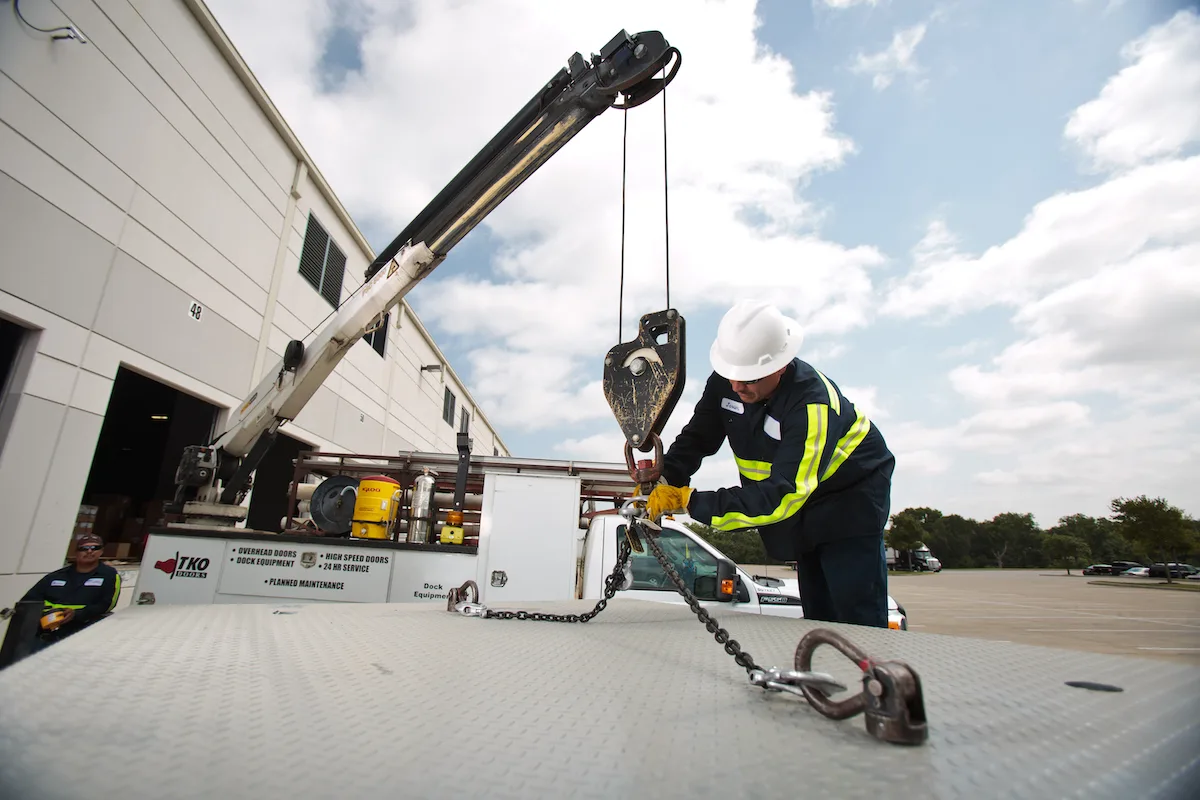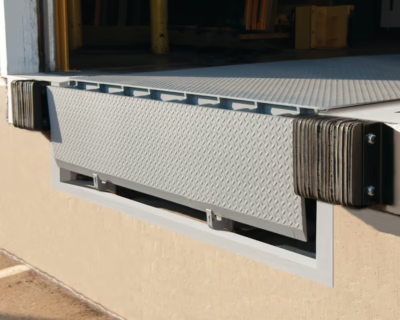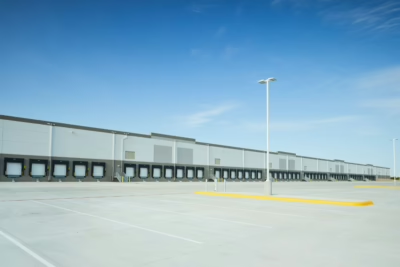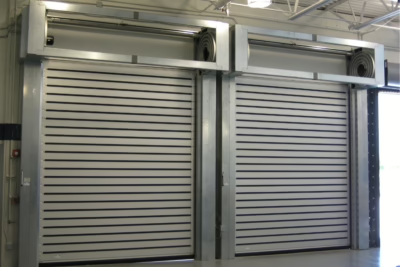Modern loading docks are busy, high-risk environments. Forklifts, trailers, employees, and heavy equipment constantly interact in fast-paced conditions. Without the right safety features in place, this activity can result in injuries, product damage, or costly downtime.
The good news? Most loading dock accidents are preventable. By integrating the right safety technologies and protocols into your dock infrastructure, you can create a secure, efficient, and compliant working environment. Below, we outline the essential safety features every modern dock should include.
Vehicle Restraint Systems
Vehicle restraints are designed to prevent trailer movement during loading and unloading. These systems keep the trailer locked in position against the dock, eliminating the risk of trailer creep or early departure — two of the most dangerous scenarios in any warehouse.
Why they’re essential:
- Prevent trailers from separating from the dock during active loading
- Eliminate reliance on manual wheel chocks
- Integrate with communication lights to signal dock status
Common types include:
- Rotating hook restraints that lock onto the trailer’s rear impact guard
- Wheel-based restraints that automatically engage trailer tires
- Manual wheel chocks, which are less secure and easier to misuse
For maximum safety, vehicle restraints should be connected to an integrated control system and paired with LED signal lights.
Dock Levelers with Built-In Safety Features
Dock levelers create a smooth transition between the warehouse floor and the trailer bed. But not all levelers are created equal — safety is heavily influenced by the leveler’s design and automation features.
Look for levelers that include:
- Automatic safety lips to prevent drop-off hazards
- Maintenance struts or support legs to hold the leveler in place during servicing
- Interlock systems that prevent leveler activation unless other safety conditions are met
Hydraulic dock levelers, in particular, reduce manual handling and offer a smoother, safer loading experience. They’re ideal for high-volume facilities.
Visual and Audio Communication Systems
Effective communication between dock personnel and truck drivers is essential for safe operations. Modern systems use visual and audio signals to indicate when it is safe to load, unload, or depart.
Recommended safety components:
- Exterior red/green signal lights to instruct drivers
- Interior lights to guide warehouse staff
- Audible alarms that trigger during unsafe conditions
- Dock control panels that integrate all systems for synchronized operation
These tools reduce miscommunication and help enforce safe operating procedures across every shift.
Safety Barriers and Dock Edge Protection
Loading dock edges present a significant fall hazard — especially when a door is open but not in use. Safety barriers act as visual and physical deterrents, protecting both workers and equipment.
Types of dock safety barriers:
- Retractable barriers that extend across open dock doors
- Heavy-duty dock gates to block entry during staging
- Edge guards and bollards that absorb forklift or pallet impacts
These barriers are especially important during periods of inactivity, maintenance, or staging.
Dock Lighting and Visibility
Poor lighting can lead to serious accidents, from misloads to missed foot traffic. Visibility is one of the easiest and most cost-effective safety upgrades available.
High-impact lighting features:
- LED dock lights that illuminate inside trailers
- Overhead lights for truck approach zones and dock bays
- Task lighting for operators during inspections or maintenance
- Color-coded indicators for dock status
LED systems last longer, use less energy, and improve clarity across all working conditions.
Dock Seals and Shelters
Dock seals and shelters improve more than just energy efficiency — they also contribute to safer dock environments.
By forming a barrier between the facility and the trailer, they:
- Reduce slips caused by wet or icy dock surfaces
- Help maintain internal temperatures for worker comfort
- Keep dust, debris, and pests out of the facility
- Enhance visibility inside the trailer by blocking ambient glare
This is especially important in cold storage, food handling, or pharmaceutical operations.
Integrated Control Systems
To maximize safety and reduce operator error, many modern loading docks rely on integrated control panels. These systems allow users to manage the dock leveler, vehicle restraint, door, lights, and barrier — all from a single interface.
Benefits of integration:
- Enforces proper equipment sequence
- Prevents unsafe operation (e.g., leveler won’t activate unless trailer is secured)
- Speeds up training for new employees
- Reduces the number of manual touchpoints
Smart dock controls often include diagnostics and indicators to alert teams of equipment issues before they lead to downtime.
Sensors and Smart Safety Technology
Sensors and automation technology are transforming how facilities approach dock safety. These tools help detect unsafe conditions in real time and trigger immediate responses.
Common sensor-based safety applications:
- Trailer presence detection to prevent false activations
- Pedestrian motion sensors to stop forklift traffic in walk zones
- Cycle counters to track equipment usage and flag when maintenance is needed
- Load sensors that confirm weight before proceeding
These technologies provide real-time alerts, improve compliance, and support predictive maintenance programs.
Preventative Maintenance and Safety Audits
Even the most advanced dock safety systems require regular upkeep. Without maintenance, safety equipment can fail — sometimes silently — leading to serious consequences.
A solid maintenance program should include:
- Daily visual checks for lights, restraints, levelers, and doors
- Monthly functional tests of restraints and interlocks
- Quarterly professional inspections by certified technicians
- Annual safety audits to assess wear, alignment, and compliance
DuraServ offers maintenance contracts that ensure all safety systems remain in top working condition and aligned with OSHA standards.
Real-World Example: Why Safety Systems Matter
A food distributor in the Southeast experienced a near-miss incident when a trailer pulled away prematurely during unloading. Fortunately, the facility had installed an automatic vehicle restraint with an interlock system — the dock leveler was disabled, and the operator was alerted before entering the trailer.
Following this event, the facility expanded its safety program with edge barriers, motion sensors, and quarterly training. Since then, they’ve reported zero loading dock incidents and improved loading times by 15%.
FAQs
Are wheel chocks a reliable safety solution?
Not entirely. Wheel chocks are better than nothing, but they’re often misplaced or improperly installed. Automated vehicle restraints offer greater reliability and security.
What’s the best lighting upgrade for safety?
LED dock lights inside trailers are one of the highest-impact upgrades. Pairing them with overhead approach lighting improves visibility for both drivers and dock staff.
How often should loading dock equipment be serviced?
Visual inspections should happen daily. Professional maintenance should be scheduled quarterly, with full audits annually or per manufacturer recommendations.
Final Thoughts
Safety isn’t just a compliance checkbox — it’s the foundation of a productive, reliable loading dock. With the right combination of equipment, technology, and preventative planning, facilities can dramatically reduce risk, increase efficiency, and protect their workforce.
DuraServ provides comprehensive loading dock safety solutions, from vehicle restraints and dock levelers to integrated systems, sensors, and service programs. Contact us today to schedule a safety assessment or explore solutions tailored to your facility.



